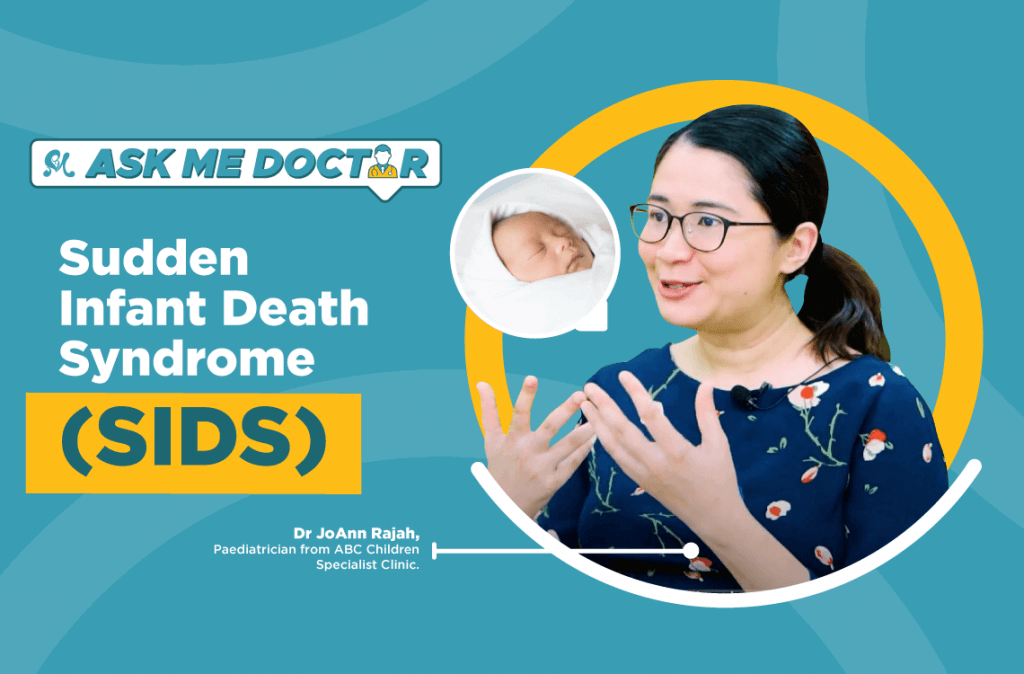Sudden Infant Deaths Syndrome (SIDS) is one of the parents’ nightmares. To ease your worries, Dr JoAnn Rajah, a Paediatrician from ABC Children Specialist Clinic is here to answer all of your questions regarding Sudden Infant Death Syndrome (SIDS) in our fifth episode of AskMeDoctor! Season 2.
Q1: What exactly is SIDS?
Dr JoAnn: SIDS stands for Sudden Infant Death Syndrome, which is the sudden and unexplained death of children under the age of 1 year old.
As most of these deaths occur during sleep and in a baby sleeping environment, it is also known as crib or cot death.
While the cause of SIDS is unknown, a lot of clinician and researchers believe that sudden infant death syndrome is due to the failure of the baby to arouse from sleep, to detect low oxygen levels in a body and carbon dioxide build-up.
Q2: Is SIDS similar to SUIDS?
Dr JoAnn: No, both of them are not synonymous. SUID or Sudden Unexpected Infant Death refers to the death of babies under the age of 1 year old which is sudden and unexpected; in which the causes are further known later on.
For example, it happened because of infections, brain abnormality, heart abnormality, metabolic disorders, and etc.
As for SIDS, it falls under the umbrella of SUID.
Q3: How common is SIDS to happen in Malaysia?
Dr JoAnn: Unfortunately, the incidents of sudden infant death in Malaysia and its trigger factor is not known. That is because we do not have any active surveillance.
If we look at history in the US for example, the sudden infant death syndrome is reported to be as high as 2 to 6 deaths for every 1,000 live births.
But ever since the introduction of the sleep safe campaign, the risk has reduced significantly by 30 to 83 percent.
Q4: Does SIDS risk by age?
Dr JoAnn: Yes. If we look at the data, sudden infant death syndrome is one of the common causes of babies below the age of 1 year old, and 95% of SIDS occur in babies less than 6 months with the peak incidence between the second to the fourth month.
Q5: Some people believe that by putting your baby to sleep in a prone position, the baby will grow up to be a brilliant kid, is that true?
Dr JoAnn: That is absolutely untrue and strongly discouraged.
Sleeping position is a high risk of sudden infant death syndrome.
By putting your child to sleep on the tummy or sleeping on the side, you are increasing the risk of sudden infant death syndrome by double compared to sleeping on the back.
Q6: Can I co-sleep with my child if he has trouble sleeping at night?
Dr JoAnn: Co-sleeping and bed-sharing is also another risk that is correlated to an increased incidence of sudden infant death syndrome. I strongly advise parents not to co-sleep with their child.
However, children under the age of 6 months are encouraged to share the same room with their parents but in their own designated cot.
Q7: Is it true that quilts, pillows, and soft toys are the risk factors of SIDS?
Dr JoAnn: Yes. All of these are actually a risk for a baby to suffocate and hence, they should not be put into the cot.
The cot should be as empty as possible. That includes no bumper pads as well.
Q8: How to prevent SIDS?
Dr JoAnn: Sudden infant death syndrome can be prevented by the following:
- Put your baby to sleep on the back. Sleeping position is very important.
- Do not do bed-sharing or co-sleeping with your child.
- Ensure that your baby’s sleeping environment is free from all hazards which include pillows, quilt, blankets, stuff toys, and bumper pads.
- Offer your baby a pacifier during sleep so that it helps to prevent sudden infant death syndrome.
- Babies under the age of 6 months are encouraged to sleep with their parents in the same room, but in a designated cot.
- A child or baby under the age of 1 year old should not be exposed to cigarette smoke either in the womb or after birth. Because cigarette smoke is also known to increase the risk of sudden infant death syndrome.
- Having a good antenatal check-up is very important because babies who are born prematurely or those with no low birth weight have a higher risk of sudden infant death syndrome.
Q9: Is sleeping in a swing safe for babies?
Dr JoAnn: Generally, sleeping in a swing is not safe.
This is because, when the child is put into the swing, there is the chance that the child might keep their chin towards their body and this can actually obstruct their upper airway leading to breathing difficulties.
Hence, every baby should be placed on a firm mattress with a fitted sheet lying on the back.
Q10: “Breastfeeding can help to cut the risk of SIDS” – is that true?
Dr JoAnn: Yes, breastfeeding has been shown to reduce the incidence of sudden infant death syndrome.
Sudden infant death may sound scary. However, it is a rare entity. For parents with babies under the age of 1 year old, your baby should practice safe sleep. It is as easy as ABC – alone, on the back, and in the cot.
Sudden Infant Death Syndrome is indeed crucial for everyone to be aware of so that we can prevent it with the correct ways suggested above.
Remember to always refer to a professional doctor or paediatrician for advice especially on Sudden Infant Death Syndrome (SIDS).
Stay tuned with AskMeDoctor! series at Motherhood Story and don’t forget to catch up with a new episode every week on our Facebook page.
